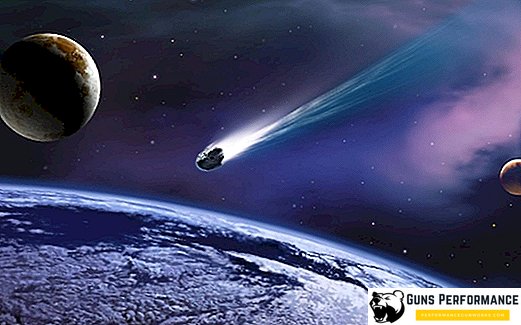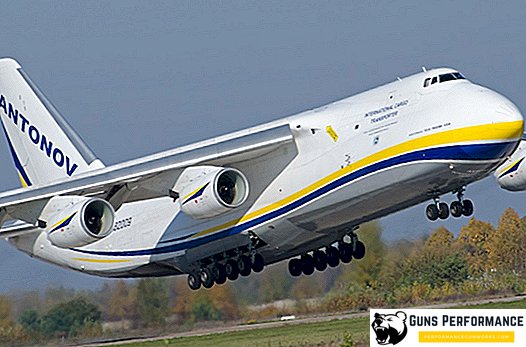Despite the colossal scale of the Universe, processes constantly occur in it that affect cosmic bodies. Galaxies move to meet each other, stars are born and die. For such large-scale cataclysms of universal scale, humanity is watching from the sidelines. All this happens far from us and threatens us only theoretically. Much more serious is the threat from events occurring in near space.
Meteorites, comets and asteroids - these space wanderers, rushing in space at a speed of 20 or more kilometers per second, have tremendous destructive power. The collision of the Earth with such a cosmic body has disastrous consequences for our world, up to the destruction of life on Earth. There are many evidences of such visits in the distant past of our planet, but this process continues to this day.

What are space meteorites?
In the process of formation, the Solar System was a gigantic construction site. After the formation of planets in outer space left a huge amount of debris, which is a solid fragments of various sizes. Larger formations have become comets and asteroids. Large asteroids have astrophysical parameters similar to planetary ones. Small asteroids are eternal wanderers, constantly exposed to the larger celestial bodies of the solar system.

Periodically, the flight routes of these cosmic wanderers intersect with the orbit of the planets, which threatens a dangerous meeting or a catastrophic collision. The extent and consequences of such a date can be very different. For the Earth, the most innocuous version of such a meeting is the flight of a meteor, which is lining the night sky with a fast bright spark. In antiquity, few people guessed that a falling star is often accompanied by meteorites falling to the surface of the Earth. Today we know that the flights of meteors can leave traces on the face of the planet. Thousands of meteorites are constantly falling on it, and other planets are experiencing a similar external effect.
Such gifts fall most often on the surface of our planet during the close passage of a meteor shower through the Earth's orbit. At that time, while everyone is enthusiastically watching the star-fall in the sky, thousands of small meteors enter the Earth’s atmosphere. The meteor shower of 1833 caused panic in the entire northern part of the western hemisphere. The cause of such an astronomical event, unprecedented for earthlings, was the Leonid meteor shower, through which our planet flew. As a result, meteor shower has passed almost throughout the US. Today, scientists have established the frequency of the Earth’s meeting with this meteor shower. Every 33 years, our planet intersects with this stream in the Universe, so the rain of 1833 may repeat again. The last such meeting took place in 1998.

The cosmic body, falling into the dense layers of the Earth’s atmosphere is collapsing. The ice melts and evaporates, and large fragments - the remnants of this swift guest, reaching the surface of the earth, becoming meteorites.
At the moment, it is customary to distinguish the following types of meteorites:
- stone heavenly bodies;
- iron meteorites.
Scientists, having received in their hands a particle or a fragment of such a guest, who fell to Earth, can judge about what building material the universe was built from. Until the spacecraft examined the soil of other planets, and man did not receive samples of the lunar rock, the meteorites were the only sources of information about cosmic matter.

The bulk of the celestial bodies that have fallen on our planet are stone meteorites. These objects can have various sizes, ranging from the largest meteorites and ending with the smallest ones - the size of a pea.
What does a meteorite look like? As a rule, such space guests most often have an irregular shape and resemble a huge boulder. Literally, the "meteorite" from the ancient Greek language is translated - "a stone from the sky."
Less often, meteorites from iron (up to 40% nickel) arrive on Earth. These visitors are smaller and consist of pure iron, of cosmic origin, which is 4.5-5.5 billion years old. Modern science is based on data and studies of cosmic material brought to us from far space over 200 years of history. Traces of falling larger meteorites are constantly being studied, giving an idea of what human civilization may encounter in the future.
Astrophysical parameters of meteorites
Meteorites can be divided into two types: fallen and found. The first are astrophysical phenomena recorded in our sky during their fall. The second relate to objects that were found by man accidentally. The first type may be of the greatest interest to science. By fixing the flight of a meteorite, and knowing exactly where it fell, scientists can get a huge amount of information. The found fragment of a meteorite or the whole fragment gives an idea of what the composition of the meteorite is and how old this guest is.

Celestial objects that have been discovered by man as a result of their vital activity can occur quite often. Every day, 5-6 tons of meteorites arrive on the surface of our planet from space. Typically, these visitors are small, but there are instances weighing up to one kilogram. In most cases, the meteorites found are pieces of iron.
In this context, the size of the meteorite is also important. The greater the cosmic body, rushing towards the Earth, the higher the probability of its inevitable collision with our blue planet.

The largest meteorite arriving from space and found by man is Goba. This is a huge iron block with a volume of 9m³.
The tremendous speed of the meteorite leads to the fact that the stone celestial bodies collapse when they fall. Iron pieces are able to fly to our planet, retaining their bulk.
The fall of the meteorite is an interesting astrophysical phenomenon. Meteorites that have reached the earth's atmosphere, rush at a speed of 20-30 km / s. The speed of a meteorite that reached the surface of the planet, respectively, is the same, but the flight itself is transient, and lasts no more than 10-15 seconds.
One can only imagine what was the speed of the fall of a meteorite, who left behind the famous Arizona crater. The famous Yucatan crater is the footprint of the largest meteorite that fell on our planet in antiquity. The place of the fall is a hollow with a diameter of 180 km, which was discovered from photographs taken from space. It is difficult to imagine what threatens the collision of the Earth with a space object of this size in modern conditions. It is possible that this was the same meteorite that put an end to dinosaurs as a whole species.

The mass of the cosmic body, multiplied by the speed with which it rushes to the Earth, gives a meteorite tremendous destructive power. The energy of a meteorite is measured in tons of TNT.
The power of the explosion of the Tunguska meteorite that exploded in the area of the Podkamennaya Tunguska River (Eastern Siberia) on June 30, 1908, is estimated by scientists at 40-50 megatons of TNT equivalent. According to approximate data, the meteorite mass was more than 100 thousand tons. As a result of the explosion, a meteorite or other celestial body exploded in the air, but the force of the explosion was such that the shock wave circled the planet twice.
The composition of a meteorite (iron or silicates), the angle of incidence and its size determine the behavior of a celestial body in the earth's atmosphere. The surface of the meteorite (crust) is exposed to high temperatures caused by the effect of friction on the layers of the earth's atmosphere. The object may also be affected by geomagnetic fields and the forces of gravity in the atmosphere. Flying through the air layer, the celestial body loses in its weight 10-19% of the original mass. Such air explosions quite often occur in the earth's atmosphere. A huge number of small particles and fragments fall onto the Earth, without carrying much destruction and devastation. A large meteorite is likely to reach the Earth’s crust, causing natural destruction by its fall. All known meteorites left traces that are scattered around the globe. The dimensions of the meteor craters indicate the dimensions of the space aliens.

It is difficult to predict where the next-comer will fall and what his behavior will be during the flight. NASA astrophysical laboratory specialists created a simulation of the behavior of a meteorite. This model allows you to pre-obtain accurate data about where the next space guest can fall and what should be expected at such a meeting.
The most famous and explored space meteorites
Modern science has a sufficient amount of collected data on meteorites visiting our planet. Data on prehistoric guests are anthropological and geological in nature. More recent data on the fall of meteorites on our planet, are already informative and more accurate scientific potential.
Of the most famous meteorites that have fallen in the new time and have undergone a detailed study, the first place is occupied by the Tungussky meteorite. Over the past 110 years since the collision, this cosmic catastrophe is considered the largest. Scientists admit that if this body fell onto the surface of the Earth, the history of human civilization could have taken a different path.

The consequences of the collision are striking in their scale. Despite the absence of a crater, the area in the area of the explosion of a celestial body was subjected to terrible devastation. During the week after the fall, unusual phenomena occurred in the Earth’s atmosphere. The aurora was observed in southern latitudes, and luminous clouds stood overhead.

The smaller meetings with space guests include the following:
- the fall of the Sikhote-Alin meteorite in February 1947;
- meteor shower in 1976, which showered several provinces of China at once;
- the fall of the iron meteorite in the area of Lake Sterlitamak in May 1990.
Collisions of the Earth with meteorites occur regularly. With the advent of modern means of tracking, it became possible to track the flights of cosmic bodies falling to the ground and quickly identify the places of their fall.
Video fixtures made it possible to capture a large-scale astronomical spectacle in 2007, when a large celestial body fell in Peru. This meteorite left behind a funnel with a diameter of 20 meters. Another meteor shower in China in February 2012 looked just as impressive. After it, more than 30 craters of various sizes were discovered. The great catastrophe of our time could be the arrival in 2012 of the Sutter Mill meteorite. This object exploded in the air at an altitude of 100 km and covered the territory of the entire Midwest USA with its fragments.
The meteorite that fell in Russia in the Chelyabinsk region on February 15, 2013 is interesting. The space body did not reach the surface of the planet and collapsed a few kilometers above the city. It was not possible to establish the exact location of the fall of this object. Fragments and fragments of the celestial body scattered over a vast territory.

Finally
Meeting our planet with space objects carries a certain threat. The mathematical model of the solar system, compiled by astrophysicists in recent years, allows us to hope that in the near future we will not face a catastrophic visit by space guests. It cannot be argued that earthlings are insured against such disasters in the future. The universe is in constant motion and the situation in space can change. Will the sky so calm in the future, time will tell.












